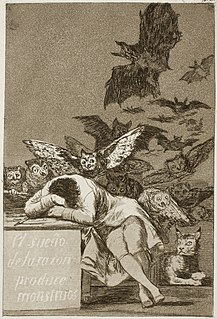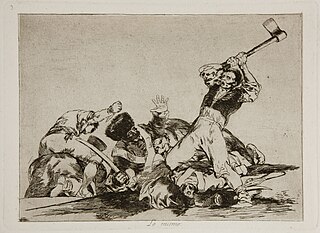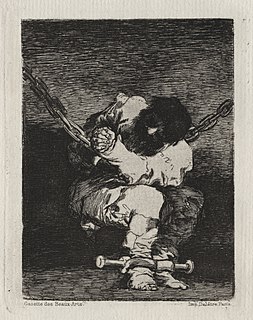
Francisco José de Goya y Lucientes was a Spanish romantic painter and printmaker. He is considered the most important Spanish artist of the late 18th and early 19th centuries. His paintings, drawings, and engravings reflected contemporary historical upheavals and influenced important 19th- and 20th-century painters. Goya is often referred to as the last of the Old Masters and the first of the moderns.

Printmaking is the process of creating artworks by printing, normally on paper, but also on fabric, wood, metal, and other surfaces. "Traditional printmaking" normally covers only the process of creating prints using a hand processed technique, rather than a photographic reproduction of a visual artwork which would be printed using an electronic machine ; however, there is some cross-over between traditional and digital printmaking, including risograph. Except in the case of monotyping, all printmaking processes have the capacity to produce identical multiples of the same artwork, which is called a print. Each print produced is considered an "original" work of art, and is correctly referred to as an "impression", not a "copy". However, impressions can vary considerably, whether intentionally or not. Master printmakers are technicians who are capable of printing identical "impressions" by hand. Historically, many printed images were created as a preparatory study, such as a drawing. A print that copies another work of art, especially a painting, is known as a "reproductive print".

Aquatint is an intaglio printmaking technique, a variant of etching that produces areas of tone rather than lines. For this reason it has mostly been used in conjunction with etching, to give both lines and shaded tone. It has also been used historically to print in colour, both by printing with multiple plates in different colours, and by making monochrome prints that were then hand-coloured with watercolour.

Intaglio is the family of printing and printmaking techniques in which the image is incised into a surface and the incised line or sunken area holds the ink. It is the direct opposite of a relief print where the parts of the matrix that make the image stand above the main surface.

Los caprichos is a set of 80 prints in aquatint and etching created by the Spanish artist Francisco Goya in 1797–1798, and published as an album in 1799. The prints were an artistic experiment: a medium for Goya's condemnation of the universal follies and foolishness in the Spanish society in which he lived. The criticisms are far-ranging and acidic; the images expose the predominance of superstition, the ignorance and inabilities of the various members of the ruling class, pedagogical short-comings, marital mistakes and the decline of rationality. Some of the prints have anticlerical themes. Goya described the series as depicting "the innumerable foibles and follies to be found in any civilized society, and from the common prejudices and deceitful practices which custom, ignorance or self-interest have made usual".

The Third of May 1808 is a painting completed in 1814 by the Spanish painter Francisco Goya, now in the Museo del Prado, Madrid. In the work, Goya sought to commemorate Spanish resistance to Napoleon's armies during the occupation of 1808 in the Peninsular War. Along with its companion piece of the same size, The Second of May 1808, it was commissioned by the provisional government of Spain at Goya's suggestion.

The Sleep of Reason is a BBC Books original novel written by Martin Day and based on the long-running British science fiction television series Doctor Who. It features the Eighth Doctor, Fitz and Trix.

The Disasters of War is a series of 82 prints created between 1810 and 1820 by the Spanish painter and printmaker Francisco Goya (1746–1828). Although Goya did not make known his intention when creating the plates, art historians view them as a visual protest against the violence of the 1808 Dos de Mayo Uprising, the subsequent Peninsular War of 1808–1814 and the setbacks to the liberal cause following the restoration of the Bourbon monarchy in 1814. During the conflicts between Napoleon's French Empire and Spain, Goya retained his position as first court painter to the Spanish crown and continued to produce portraits of the Spanish and French rulers. Although deeply affected by the war, he kept private his thoughts on the art he produced in response to the conflict and its aftermath.

The Sleep of Reason Produces Monsters or The Dream of Reason Produces Monsters is an aquatint by the Spanish painter and printmaker Francisco Goya. Created between 1797 and 1799 for the Diario de Madrid, it is the 43rd of the 80 aquatints making up the satirical Los caprichos.

The Colossus, is known in Spanish as El Coloso and also El Gigante, El Pánico and La Tormenta. It is a painting traditionally attributed to Francisco de Goya that shows a giant in the centre of the canvas walking towards the left hand side of the picture. Mountains obscure his legs up to his thighs and clouds surround his body; the giant appears to be adopting an aggressive posture as he is holding one of his fists up at shoulder height. A dark valley containing a crowd of people and herds of cattle fleeing in all directions occupies the lower third of the painting.

Witches' Sabbath or The Great He-Goat are names given to an oil mural by the Spanish artist Francisco Goya, completed sometime between 1821 and 1823. It explores themes of violence, intimidation, aging and death. Satan hulks, in the form of a goat, in moonlit silhouette over a coven of terrified witches. Goya was then around 75 years old, living alone and suffering from acute mental and physical distress.

Los disparates, also known as Proverbios (Proverbs) or Sueños (Dreams), is a series of prints in etching and aquatint, with retouching in drypoint and engraving, created by Spanish painter and printmaker Francisco Goya between 1815 and 1823. Goya created the series while he lived in his house near Manzanares on the walls of which he painted the famous Black Paintings. When he left to France and moved in Bordeaux in 1824, he left these works in Madrid apparently incomplete. During Goya's lifetime, the series was not published because of the oppressive political climate and of the Inquisition.

The Black Paintings is the name given to a group of 14 paintings by Francisco Goya from the later years of his life, likely between 1819 and 1823. They portray intense, haunting themes, reflective of both his fear of insanity and his bleak outlook on humanity. In 1819, at the age of 72, Goya moved into a two-story house outside Madrid that was called Quinta del Sordo. Although the house had been named after the previous owner, who was deaf, Goya too was nearly deaf at the time as a result of an unknown illness he had suffered when he was 46. The paintings originally were painted as murals on the walls of the house, later being "hacked off" the walls and attached to canvas by owner Baron Frédéric Émile d'Erlanger. They are now in the Museo del Prado in Madrid.

La Tauromaquia (Bullfighting) is a series of 33 prints created by the Spanish painter and printmaker Francisco Goya, which was published in 1816. The works of the series depict bullfighting scenes. There are also seven extra prints that were not published in the original edition.

Eleanor Axson Sayre was an American curator, art historian, and a specialist on the works of Goya. She was the first woman to serve as departmental curator at the Museum of Fine Arts, Boston. Working as curator of prints and drawings, she collected Goya's etchings from museums around the world to catalogue and create international exhibits. She was awarded a knighthood with the Lazo de Dama in the Order of Isabella the Catholic by Spain in 1975 and the Gold Medal of Merit in the Fine Arts in 1991.

A way of flying is a print by the Spanish painter and printmaker Francisco Goya. Created between 1815 and 1816, it is the 13th of the 22 aquatints making up the series Los disparates. Along with the rest of the series it was first published in 1864 by the Real Academia de Nobles Artes de San Fernando.

In printmaking, surface tone, or surface-tone, is produced by deliberately or accidentally not wiping all the ink off the surface of the printing plate, so that parts of the image have a light tone from the film of ink left. Tone in printmaking meaning areas of continuous colour, as opposed to the linear marks made by an engraved or drawn line. The technique can be used with all the intaglio printmaking techniques, of which the most important are engraving, etching, drypoint, mezzotint and aquatint. It requires individual attention on the press before each impression is printed, and is mostly used by artists who print their own plates, such as Rembrandt, "the first master of this art", who made great use of it.

The Prisoners is a series of three etchings by Francisco de Goya, depicting imprisoned men with indistinct faces, bound with leg irons in stress positions. The prints are not dated, but they are believed to have been made between 1810 and 1815, around the time Goya started his print series The Disasters of War. Political considerations made it impossible for Goya to publish the prints during his lifetime.




















